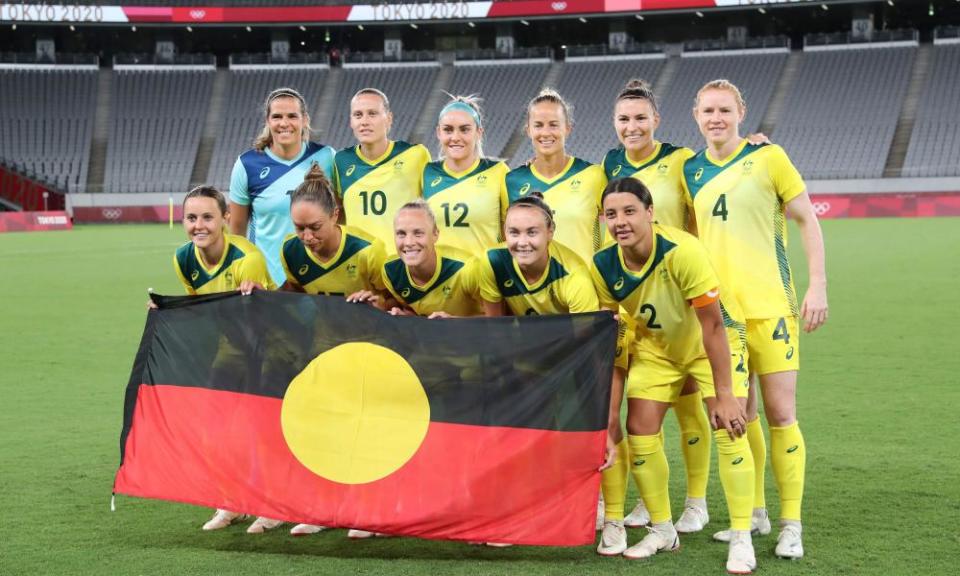Matildas strike balance in search for team identity in Olympics opener

“What is our identity?” It was a football-focused question, to be sure, based on tactics and systems. But Matildas head coach Tony Gustavsson seemed to touch on something deeper when he was asked, mid-way through Australia’s pre-Tokyo friendly series, what he wanted to learn from his new group of players.
It was not about the nuts and bolts of how they played, necessarily. It was about who they were when they did so: what they embodied, what they represented, how they made themselves and other people feel.
Related: Sam Kerr ignites attack as Matildas beat New Zealand 2-1 in Tokyo Olympics opener
Moments before their opening match against New Zealand on Wednesday night, Australia began to answer that question. While many teams across the women’s football tournament decided to take a knee in solidarity with the Black Lives Matter movement, the Matildas chose to do something different – something unique and meaningful to them.
Instead of kneeling, Australia’s players unfurled an Aboriginal flag, posing behind it for the traditional pre-game team photo. With two First Nations women among them – goalkeeper Lydia Williams and striker Kyah Simon – this gesture seemed to come from a deep and earnest place.
As captain Sam Kerr said after the match, “It was something that we spoke a lot to as a team. We let the Indigenous girls drive it. We felt that we didn’t want to just do something to go with the grain; we wanted to do something that was relevant to our country and show unity within our group and let everyone feel that they’re represented. We feel really proud of it.”
It was a striking image: a union of Australia’s ancient past with its modern present. And that, perhaps, is why it seemed so fitting a symbol for this Matildas side; a side that is in the midst of discovering how to balance the old with the new.
That transition was visible in the squad selection itself, with Olympic debuts handed out to 36-year old Aivi Luik – the oldest Matilda to play in a major tournament – as well as teenagers Mary Fowler and Kyra Cooney-Cross, both of whom earned their first official senior caps and are widely seen as the future of the national team.
It was visible, too, in the game itself. In the five friendlies leading into this opening match, despite their gradually improving scorelines and performances, there was none the less a puzzling feeling that hung over each game. Experiments with formations and players aside, it still felt as though the Matildas weren’t quite playing like them.

Against New Zealand, though, that troublesome feeling began to transform into the fizzy delight that fans have long associated with this team. The opening half was particularly joyful, in part due to Gustavsson’s subtle shifts in formation. Both Steph Catley and Ellie Carpenter – while still being deployed on either side of a fluid back three – were given more licence to gallop down either wing in alternating patterns, creating the kind of overloading layers and creative outlets that had been largely lacking in recent games.
Similarly, Tameka Yallop – who had been shackled to a wide-left role in her friendly appearances – was invited back into her more comfortable box-to-box midfield role, freeing up Emily van Egmond to drive further forward. Both of them, alongside the more central Kyah Simon, also provided the previously-isolated Sam Kerr with extra moving bodies to combine with.
The result was Yallop opening the scoring after just 20 minutes of play: a neat one-two with Kerr allowing her to slice through New Zealand’s defenders from a deep midfield role and rifle her shot into the roof of the net.
Australia’s second goal came just over 10 minutes later as Catley, who had been on corner duty all night, telepathically read the run of Kerr towards the front post and clipped a perfect, curling ball in for the striker to head home.
Related: Why the USWNT shouldn’t panic about their Olympic thrashing by Sweden (yet)
Simon, for her part, had her best game under Gustavsson’s tenure. Given the freedom to float in and out of central channels, sweeping in and around both Kerr and Caitlin Foord, the veteran striker was a lick of rust away from scoring at least twice from her game-leading five shots (including three on target). Catley, too, seemed to have put the ghosts of an injury-ravaged season behind her to lead the entire field in crosses (13) and chances created (five) by the full-time whistle.
But for a late goal from emerging Kiwi star Gabbie Rennie, Australia also kept New Zealand to just six shots all night; a comfortable defensive display to complement the rediscovered attacking flair. This, then, is where the Matildas’ identity seems to lie: in the balance between old feelings and new forms. Finally, it seems, Gustavsson is beginning to strike it.

 Yahoo Sport
Yahoo Sport 





































